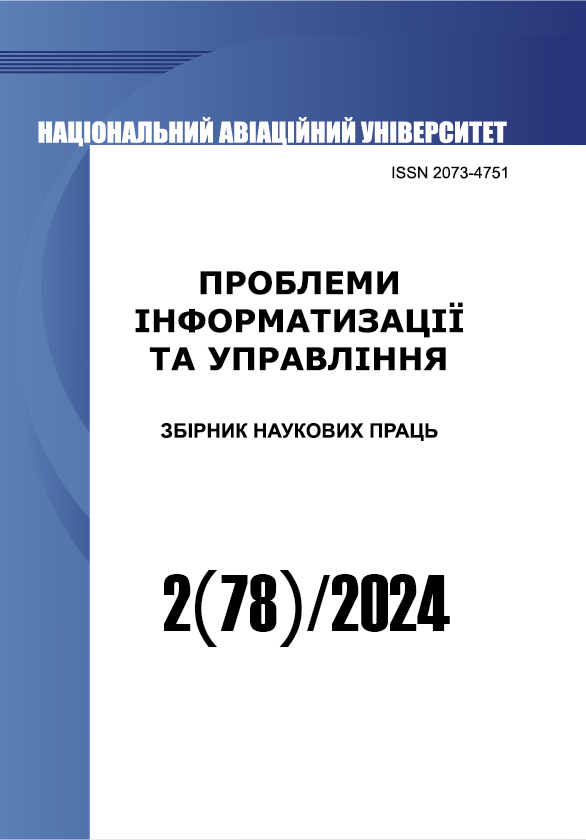Модель інтернет мережі з урахуванням мережевого розташування
DOI:
https://doi.org/10.18372/2073-4751.78.18970Ключові слова:
структура мережі, Інтернет речей, послаблення сигналу перешкодами, відношення сигнал/шум, прямокутна решітка, перколяція, теорія графів, імітаційне моделюванняАнотація
Метою даного дослідження є доведення корисності висновків теорії перколяції для оцінки зв'язності мережі Інтернету речей. Ймовірність наявності маршруту між двома парами вузлів визначає зв’язність мережі. Коли ця ймовірність наближається до одиниці, мережу вважають зв'язною. Наприклад, можна використовувати пошук найкоротших шляхів між усіма парами вузлів (вершинами графа, що описує мережу) для оцінки зв’язності в конкретній ситуації. Дві причини ускладнюють розв’язання цієї проблеми. По-перше, обчислювальний ресурс, необхідний для цього, зростає пропорційно до n3, де n – кількість вершин графа. По-друге, існуючі аналітичні підходи зазвичай спрямовані на конкретні випадки, а не на велику кількість вузлів.
У статті запропонована модель мережі у вигляді решітки, яка слугує логічною основою для структурування зв'язків між вузлами, розташованими в різних приміщеннях. Форма решітки контролюється плануванням будівлі. Отримана модель дозволяє оцінити ефективність каналу зв'язку за допомогою оцінки ПСП та загального відношення СШ для вузлів мережі. Використання моделі дозволяє впевнено стверджувати, що в сучасній багатоповерховій структурі, якщо вузли стратегічно розміщені в кожній кімнаті, цілком можливо створити бездротову мережу зв'язку. Крім того, якість радіоканалу дозволяє використовувати швидкості передачі даних, які відповідають найвищим стандартам сучасних технологій.
Посилання
Perera, C. et al. Context Aware Computing for The Internet of Things: A Survey. IEEE Communications Surveys & Tutorials. 2014. Vol. 16(1). P. 414–454.
Wang X. et al. Multipath TCP: Topology and Performance in High-Density IoT. IEEE Communications Magazine. 2015. Vol. 53(12). P. 140–147.
Bielsa G., Jukan A., Vujicic B. Wireless Network Modeling: From Delay to Performance Prediction. IEEE Communications Magazine. 2017. Vol. 55(10). P. 30–36.
Rangan S., Krishnan K., Goyal V. K. Millimeter-Wave Wireless Networks: A Survey. IEEE Communications Magazine. 2014. Vol. 52(12). P. 56–63.
Bianchi G., Tinnirello I. IEEE 802.11ac in the Unlicensed Band: A Survey on Its Coexistence with IEEE 802.11af. IEEE Communications Surveys & Tutorials. 2017. Vol. 19(2). P. 757–794.
Mehta N. B., Patel N. P., Shah M. A Survey on Channel Bonding Techniques in Wireless Networks. IEEE Communications Surveys & Tutorials. 2016. Vol. 18(3). P. 1948–1973.
Zhang C. et al. A Survey on Software-Defined Wireless Networking. IEEE Communications Surveys & Tutorials. 2015. Vol. 17(1). P. 559–580.
Cui T., Zhang R., Cui J. H. A Survey on Indoor Localization with Wireless Local Area Networks. IEEE Communications Surveys & Tutorials. 2014. Vol. 16(1). P. 10–27.
Chen M. et al. Internet of Things (IoT) and Its Applications in Smart Agriculture. IEEE Access. 2017. Vol. 5. P. 16241–16258.
Duan L., Chen C., Xie X. A Survey on Data Center Networking for Cloud Computing. IEEE Communications Surveys & Tutorials. 2017. Vol. 19(2). P. 1157–1179.
Goldsmith A. Wireless Communications. Cambridge : University Press, 2005. 250 p.
Tse D., Viswanath P. Fundamentals of Wireless Communication. Cambridge : University Press, 2005. 564 p.
Baccarelli E. et al. Optimal and energy-efficient distribution of virtual machines for cloud computing. Future Generation Computer Systems. 2011. Vol. 28(1). P. 147–154.
Akyildiz I. F., Wang X. Wireless Mesh Networks. Chichester : John Wiley & Sons, 2009. 324 p.
Stauffer D., Aharony A. Introduction to Percolation Theory. Rev., 2nd ed. London : Taylor & Francis, 1994. 181 p.
Sahimi M. Applications of Percolation Theory. London : Taylor & Francis, 1994. 258 p.
Grimmett G. Percolation. 2nd ed. Berlin : Springer, 1999. 444 p.
Broadbent S. R., Hammersley J. M. Percolation processes: I. Crystals and mazes. Mathematical Proceedings of the Cambridge Philosophical Society. 1957. Vol. 53(3). P. 629–641.
##submission.downloads##
Опубліковано
Номер
Розділ
Ліцензія
Автори, які публікуються у цьому журналі, погоджуються з наступними умовами:- Автори залишають за собою право на авторство своєї роботи та передають журналу право першої публікації цієї роботи на умовах ліцензії Creative Commons Attribution License, котра дозволяє іншим особам вільно розповсюджувати опубліковану роботу з обов'язковим посиланням на авторів оригінальної роботи та першу публікацію роботи у цьому журналі.
- Автори мають право укладати самостійні додаткові угоди щодо неексклюзивного розповсюдження роботи у тому вигляді, в якому вона була опублікована цим журналом (наприклад, розміщувати роботу в електронному сховищі установи або публікувати у складі монографії), за умови збереження посилання на першу публікацію роботи у цьому журналі.
- Політика журналу дозволяє і заохочує розміщення авторами в мережі Інтернет (наприклад, у сховищах установ або на особистих веб-сайтах) рукопису роботи, як до подання цього рукопису до редакції, так і під час його редакційного опрацювання, оскільки це сприяє виникненню продуктивної наукової дискусії та позитивно позначається на оперативності та динаміці цитування опублікованої роботи (див. The Effect of Open Access).


